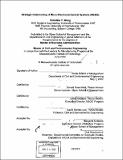| dc.contributor.advisor | Donald Rosenfield and James Masters. | en_US |
| dc.contributor.author | Wong, Christine Y., 1975- | en_US |
| dc.contributor.other | Leaders for Manufacturing Program. | en_US |
| dc.date.accessioned | 2008-12-08T22:09:42Z | |
| dc.date.available | 2008-12-08T22:09:42Z | |
| dc.date.issued | 2002 | en_US |
| dc.identifier.uri | http://hdl.handle.net/1721.1/43726 | |
| dc.description | Thesis (M.B.A.)--Massachusetts Institute of Technology, Sloan School of Management; and, (S.M.)--Massachusetts Institute of Technology, Dept. of Civil and Environmental Engineering; in conjunction with the Leaders for Manufacturing Program at MIT, 2002. | en_US |
| dc.description | "June 2002." | en_US |
| dc.description | Includes bibliographical references (leaves 60-61). | en_US |
| dc.description.abstract | ABB Automation is starting to experiment with Micro-electrical Mechanical Systems (MEMS) as an enabling technology for their products. If ABB's implementation of MEMS is found successful, it will be able to create breakthrough products and services that will revolutionize the market in ABB's industrial sensors, instrumentation and analytical areas. The thesis begins with a description of ABB as a company and then provides a brief overview on MEMS and the challenges ABB faces as it tries to commercialize MEMS enabled products. A literature review is also included to explain how companies can better profit from technological innovations such as MEMS. An analysis of ABB's decision to outsource MEMS is described with multiple frameworks including a vertical integration versus outsourcing model as well as a traditional make or buy decision assessment from a financial perspective. The decision to outsource is valid given the stage of the technological life cycle and the company's resolution to use MEMS in selected products. Since the strategic fit argument is still questionable through much of ABB, outsourcing is a legitimate choice for MEMS. Outsourcing allows a greater amount of flexibility and the least amount of capital investment. Although ABB has decided to outsource its MEMS capabilities, it has to realize that there is a possibility of vertical market failure with MEMS. There are very few suppliers in the market today with potentially fewer in the future as mergers and acquisitions begin to take place once a dominant design is established. This vertical market failure encourages vertical integration and not outsourcing. | en_US |
| dc.description.statementofresponsibility | Christine Y. Wong. | en_US |
| dc.format.extent | 68 leaves | en_US |
| dc.language.iso | eng | en_US |
| dc.publisher | Massachusetts Institute of Technology | en_US |
| dc.rights | M.I.T. theses are protected by
copyright. They may be viewed from this source for any purpose, but
reproduction or distribution in any format is prohibited without written
permission. See provided URL for inquiries about permission. | en_US |
| dc.rights.uri | http://dspace.mit.edu/handle/1721.1/7582 | en_US |
| dc.subject | Sloan School of Management. | en_US |
| dc.subject | Civil and Environmental Engineering. | en_US |
| dc.subject | Leaders for Manufacturing Program. | en_US |
| dc.title | Strategic outsourcing of micro-electromechanical systems (MEMS) | en_US |
| dc.title.alternative | Strategic outsourcing of MEMS | en_US |
| dc.type | Thesis | en_US |
| dc.description.degree | S.M. | en_US |
| dc.description.degree | M.B.A. | en_US |
| dc.contributor.department | Leaders for Manufacturing Program at MIT | en_US |
| dc.contributor.department | Massachusetts Institute of Technology. Department of Civil and Environmental Engineering | |
| dc.contributor.department | Sloan School of Management | |
| dc.identifier.oclc | 50655500 | en_US |

